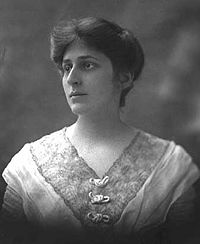Crystal Eastman
Crystal Eastman (June 25, 1881 - July 8, 1928) was a lawyer, antimilitarist, feminist, socialist, and journalist. She was born in Marlborough, Massachusetts and graduated from Vassar College in 1903, receiving an M.A. in sociology from Columbia University in 1904. She was second in the class of 1907 at New York University Law School.
Social efforts
Social work pioneer and journal editor Paul Kellogg offered Eastman her first job, investigating labor conditions for The Pittsburgh Survey sponsored by the Russell Sage Foundation. Her report, Work Accidents and the Law (1910), became a classic and resulted in the first workers' compensation law, which she drafted while serving on a New York State commission. She continued to campaign for occupational safety and health while working as an investigating attorney for the U.S. Commission on Industrial Relations during Woodrow Wilson's presidency.
Emancipation
During a brief marriage, Eastman lived in Milwaukee and managed the unsuccessful 1912 Wisconsin suffrage battle. When she returned east in 1913 she joined Alice Paul, Lucy Burns, and others in founding the militant Congressional Union, which became the National Woman's Party. After women won the vote, Eastman and three others wrote the Equal Rights Amendment introduced in 1923. One of the few socialists to endorse the ERA, she warned that protective legislation for women would mean only discrimination against women. Eastman claimed that one could assess the importance of the ERA by the intensity of the opposition to it, but she felt that "this is a fight worth fighting even if it takes ten years."
Peace efforts
During World War I, Eastman founded the Woman's Peace party and was president of the New York branch. Renamed the Women's International League for Peace and Freedom in 1921, it remains the oldest extant women's peace organization. Eastman also became executive director of the American Union Against Militarism, which lobbied against America's entrance into the European war and more successfully against war with Mexico in 1916, sought to remove profiteering from arms manufacturing, and campaigned against conscription and imperial adventures. When the United States entered World War I, Eastman organized with Roger Baldwin the National Civil Liberties Bureau to protect conscientious objectors, or in her words: To maintain something over here that will be worth coming back to when the weary war is over. The NCLB grew into the American Civil Liberties Union, with Baldwin at the head and Eastman functioning as attorney in charge. Eastman is credited as a founding member of the ACLU, but her role as founder of the NCLB may be largely ignored by posterity due to her personal differences with Baldwin.
Eastman had married British poet and antiwar activist Walter Fuller in 1916 with whom she had two children, and worked with him until the end of the war, when he returned to England to find work.
Post-War
After the war, Eastman organized the First Feminist Congress in 1919, she co-owned and edited a radical journal of politics, art, and literature, The Liberator, with her brother Max and she commuted between London, to be with her husband, and New York, where she was blacklisted and thus rendered unemployable during the Red Scare of 1919-1921. During the 1920s her only paid work was as a columnist for feminist journals, notably Equal Rights and Time and Tide. Eastman claimed that "life was a big battle for the complete feminist," but she was convinced that the complete feminist would someday achieve total victory.
Eastman has been called one of the United States' most neglected leaders, because, although she wrote pioneering legislation and created long-lasting political organizations, she disappeared from history for fifty years.
Reference
Blanche Wiesen Cook, ed., Crystal Eastman on Women and Revolution (1978).
Credits
New World Encyclopedia writers and editors rewrote and completed the Wikipedia article in accordance with New World Encyclopedia standards. This article abides by terms of the Creative Commons CC-by-sa 3.0 License (CC-by-sa), which may be used and disseminated with proper attribution. Credit is due under the terms of this license that can reference both the New World Encyclopedia contributors and the selfless volunteer contributors of the Wikimedia Foundation. To cite this article click here for a list of acceptable citing formats.The history of earlier contributions by wikipedians is accessible to researchers here:
The history of this article since it was imported to New World Encyclopedia:
Note: Some restrictions may apply to use of individual images which are separately licensed.
